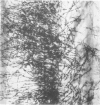Abstract
Photosynthetic and respiratory activities have been measured in leaves of Hordeum vulgare L. var. Manchuria (barley) after infection with Erysiphe graminis var. hordei (powdery mildew). Two isogenic lines, one resistant to infection and the other highly susceptible, were examined.
These isogenic lines showed very different physiological responses following infection. Photosynthesis and the chlorophyll content of resistant leaves was unaffected by infection. Respiration increased slightly and this was accompanied by small increases in activities of enzymes of glycolysis, the pentose-P pathway and the tricarboxylic acid cycle.
The infection of susceptible leaves resulted in a slight increase in photosynthesis 48 hours after inoculation, but subsequently there was a progressive decrease in the photosynthesis of these leaves compared with that of noninfected leaves. The capacity of infected leaves for partial reactions of photosynthesis such as the Hill reaction and the photoreduction of nicotinamide adenine dinucleotide phosphate (NADP1) decreased during the later stages of infection. The levels of chlorophyll, NADPH-diaphorase and aldolase also declined. There was no detectable difference in the respiration of infected and noninfected leaves until 48 hours after inoculation. After this time, the infected leaves showed a higher respiration, the maximum difference occurring about 144 hours after inoculation. The respiratory increase was not accompanied by significant changes in the levels of enzymes of glycolysis and the tricarboxylic acid cycle with the exception of malate dehydrogenase which was lower in infected leaves. In contrast, the activities of glucose-6-P dehydrogenase and 6-P-gluconate dehydrogenase showed changes similar to that observed for respiration.
The respiration and the activities of glucose-6-P dehydrogenase and 6-P-gluconate dehydrogenase did not increase in infected leaves of etiolated plants, even when excellent growth of the fungus was established by growing the plants in White's basal medium supplemented with sucrose. The respiration of a susceptible mutant barley (the yellow-green virescent mutant of the variety Himalaya) when grown in the light at 11° was not changed by infection although the characteristic respiratory rise occurred in plants grown at 15°. At the lower temperature chloroplasts fail to develop in this mutant, although development is normal at 15°.
It is suggested that the pathogen is not directly responsible for the increase in respiration in green leaves, rather that this is a response in the host cells to a loss of photosynthetic capacity.
Full text
PDF








Images in this article
Selected References
These references are in PubMed. This may not be the complete list of references from this article.
- CLAPHAM P. A. Sarcocystis sp. in the red-legged partridge, Alectoris rufa, and the pheasant, Phasianus colchicus. Nature. 1957 Dec 7;180(4597):1294–1294. doi: 10.1038/1801294a0. [DOI] [PubMed] [Google Scholar]
- SAN PIETRO A., LANG H. M. Photosynthetic pyridine nucleotide reductase. I. Partial purification and properties of the enzyme from spinach. J Biol Chem. 1958 Mar;231(1):211–229. [PubMed] [Google Scholar]
- Scott K. J., Craigie J. S., Smillie R. M. Pathways of Respiration in Plant Tumors. Plant Physiol. 1964 May;39(3):323–327. doi: 10.1104/pp.39.3.323. [DOI] [PMC free article] [PubMed] [Google Scholar]
- Smillie R. M. Photosynthetic & respiratory activities of growing pea leaves. Plant Physiol. 1962 Nov;37(6):716–721. doi: 10.1104/pp.37.6.716. [DOI] [PMC free article] [PubMed] [Google Scholar]
- Udvardy J., Horváth M., Kisbán K., Dézsi L., Farkas G. L. Alteration of enzyme activities in detached leaves and their counteraction by kinetin. Experientia. 1964 Apr 15;20(4):214–215. doi: 10.1007/BF02135409. [DOI] [PubMed] [Google Scholar]
- Wang C. H., Doyle W. P., Ramsey J. C. Role of Hexose Monophosphate Pathway in Tomato Catabolism. Plant Physiol. 1962 Jan;37(1):1–7. doi: 10.1104/pp.37.1.1. [DOI] [PMC free article] [PubMed] [Google Scholar]
- Yamamoto Y. Pyridine Nucleotide Content in the Higher Plant. Effect of Age of Tissue. Plant Physiol. 1963 Jan;38(1):45–54. doi: 10.1104/pp.38.1.45. [DOI] [PMC free article] [PubMed] [Google Scholar]




